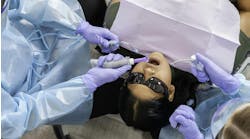The dental care landscape is changing. Higher out-of-pocket costs and relatively static benefit contributions and maximums mean patients are shouldering more financial responsibility when it comes to their oral health care. We’ve all had patients, with and without dental benefits, who are surprised by the out-of-pocket cost for their dentistry. This reaction is certainly not what we want when our goal is to get patients healthy.
The Dental Lifetime of Care study was recently released and revealed the out-of-pocket cost of dental care for the average adult surveyed aged 20–79 ranges from $51,000 to more than $95,000 during a lifetime. This includes single coverage, couple coverage, and family coverage. This figure does not include complex or elective dental treatment such as implants and orthodontics. The study, created by Synchrony on behalf of CareCredit, provides dentists and their teams with insights that can enable them to help patients become more informed and prepared for the cost of care.
You might also want to read: Fitting the financial conversation into the patient care experience
We can enhance understanding
When patients are surprised, it’s usually because they don’t understand costs, are unprepared, or are focused on keeping their household budget in check. People may be feeling a financial pinch. The study found that 58% of respondents believe dental care is not affordable, including patients with dental benefits. Additionally, 54% of respondents said they did not go to the dentist in 2022 because of cost.
Only 30% of respondents found it easy to understand dental costs, half of insured respondents did not know their annual maximum, and just a quarter knew their annual premium. So, what does this mean and how can the dental community make it easier for people to get the dental work they need and want? The answer is clear when we look at it from the patient’s point of view. Patients want to be able to eat without discomfort, have a confident smile, keep their teeth for life, and they want us to make this easy for them.
What we can do: First and foremost, we can make things easier for our patients when it comes to cost, value, and paying for care. A confused patient may make the choice to do nothing. We can invest the time to clearly communicate the value and cost of care. We can communicate to patients in a way that helps them develop a clear understanding of their benefits and potential out-of-pocket costs.
Before their appointment this can be done through the practice website and by pointing them toward educational information such as CareCredit’s WellU, a collection of patient education articles, videos, and podcasts on topics ranging from hygiene to implants. In practice, we can remember that people retain information in different ways, so we can show and tell them information. At the end of the discussion about fees and insurance benefits, ask, “Many of our patients have questions. What’s on your mind?”
We can help patients manage the cost of care
Another key finding in the Dental Lifetime of Care study was that 59% of respondents ignore, wait, or choose a less costly dental procedure. This is often not good for them. We all know that preventive care is important because oral health is connected to overall health and when left untreated, dental conditions can result in more problems and expenses. This is not good for our practices. When patients feel like care is not affordable and ignore or wait to schedule, it can impact treatment acceptance, revenue, patient retention, and cash flow.
If the cost was completely covered by their dental benefits, many probably wouldn’t hesitate to accept recommended treatment. Again, this goes back to what patients want. For the most part, I’ve found those who want care may just need an easy way forward that will allow them to better control their oral health and manage the out-of-pocket costs. In fact, 58% of respondents indicated they would “probably” or “definitely” choose a payment option that provided predictable, set, equal payments without having to use their credit cards.
What we can do: We can be transparent about our payment options. We’ve found that if we stick to one main financing company (we accept the CareCredit credit card) and have financing included at relevant touchpoints where cost may be a concern, patients stress less about money. We always present an estimated monthly payment with financing along with the total cost of care so that patients know their options and can choose what works best for them.
We can’t control interest rates or the economy. We can’t control the financial priorities of patients, so let’s focus on what we can do. We can take responsibility for the way we educate patients, present the cost of dentistry, and explain their benefits, and provide them a path to get healthy so they can better understand and manage their benefits and out-of-pocket costs. They’ll ultimately get a healthy and beautiful smile they can enjoy for life.
This content is subject to change without notice and offered for informational use only. You are urged to consult with your individual advisors with respect to any information presented. Synchrony and any of its affiliates, including CareCredit (collectively, “Synchrony”), makes no representations or warranties regarding this content and accepts no liability for any loss or harm arising from the use of the information provided. All statements and opinions in this article are the sole opinions of the author. Your receipt of this material constitutes your acceptance of these terms and conditions.
Editor's note: This article originally appeared in DE Weekend, the newsletter that will elevate your Sunday mornings with practical and innovative practice management and clinical content from experts across the field. Subscribe here.







